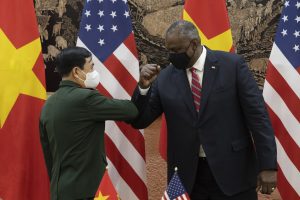After a slow start, the Biden administration is stepping up its diplomatic engagement with Southeast Asia, in a bid to dispel lingering concerns over American commitment to a region dating back to the early days of the Trump administration.
According to a senior state department official cited by Reuters, U.S. Secretary of State Antony Blinken is set to attend a flurry of virtual meetings with Southeast Asian officials every day this week. Blinken will attend annual meetings of the 10 foreign ministers of the Association of Southeast Asian Nations (ASEAN) and separate meetings of the Lower Mekong subregion countries. The unnamed official described Blinken’s attendance at the meetings as “a clear demonstration of our commitment to the region.”
While attending virtual summits requires less effort than doing so in person, Blinken’s attendances follow a string of in-person visits to the region by high-ranking U.S. officials. Last week, Defense Secretary Lloyd Austin undertook a regional tour that included stops in Vietnam, Singapore, and the Philippines, during which he reinforced the U.S. commitment to the nations contesting China’s expansive claims in the South China Sea and secured a retraction of President Rodrigo Duterte’s decision to terminate the Visiting Forces Agreement (VFA), a key part of the U.S.-Philippine alliance.
Deputy Secretary of State Wendy Sherman visited Indonesia, Cambodia, and Thailand in May and June, while Vice President Kamala Harris is set to visit Singapore and Vietnam later this month.
This flurry of engagements represents a recognition that Washington’s “Indo-Pacific” strategy hinges on its engagement with Southeast Asia, the quintessentially Indo-Pacific region. As Kurt Campbell, the National Security Council’s Indo-Pacific coordinator, said at an Asia Society event recently, “For an effective Asia strategy, for an effective Indo-Pacific approach, you must do more in Southeast Asia.”
Yet the region of 630 million has often been overlooked by the U.S. – at least as measured in diplomatic face-time, an important metric in the orbits of ASEAN-centered summitry. After two terms of punctilious attendance at the annual East Asia Summit and other ASEAN meetings by President Barack Obama, his predecessor Donald Trump didn’t bother to attend most of them, dispatching relatively junior officials in his place, while focusing overwhelmingly on security engagement with the region. During a U.S.-ASEAN Summit in 2019, this even prompted several Southeast Asian nations to downgrade their own delegations in response.
This stagnancy seemed set to continue under President Joe Biden, which initially prioritized coordinating the Quad partnership, which includes Japan, India, and Australia, to help check China’s burgeoning power and ambition in Asia. The U.S. absence was thrown into relief by an intensified Chinese engagement with Southeast Asian nations final months of the Trump administration and the first months of Biden’s tenure.
Foreign Minister Wang Yi has visited nine of the 10 ASEAN nations since October, while four Southeast Asian foreign ministers visited China in late March and early April. Wang then hosted all 10 of ASEAN’s foreign ministers in Chongqing at the start of June.
In all of these meetings, Chinese diplomats have tuned their messages to the economic and public health challenges posed by the COVID-19 pandemic, which is surging in many Southeast Asian countries, and presented China as an inexorable partner for the region in its recovery, in comparison to the episodic and fickle nature of engagement under Trump. Indeed, the region has been a key focus of Beijing’s vaccine diplomacy, accounting for 29 percent of its total vaccine donations and 25.6 percent of its global vaccine sales since the beginning of the pandemic.
Accordingly, in recent months, the Biden administration has also upped its own vaccine diplomacy efforts to the region, with 3 million doses of Moderna COVID-19 vaccine dispatched to Vietnam yesterday, and additional shipments made other Southeast Asian nations, some via the World Health Organization’s COVAX facility. By the middle of last week, the U.S. had donated 23 million doses of vaccine to Southeast Asia, according to the State Department official cited by Reuters.
While the increased U.S. outreach will be welcomed in most Southeast Asian capitals, challenges and differences will no doubt remain. As Derek Grossman, a columnist for The Diplomat, noted on Twitter, the praise for Austin’s recent trip was warranted, but it was important to bear in mind that it took the administration “nearly six months to do anything substantive,” while noting that Biden is yet to call any Southeast Asian leader. It is also likely that there many issues – including human rights questions and fundamental differences in the two regions’ threat perceptions of China – will remain the subject of disagreement and occasional tension.
That said, while the U.S. still views Southeast Asia as sitting downstream of the looming question of how to contain Chinese power and ambition, there are more signs that the Biden administration is working up a positive U.S. diplomatic agenda for the region, one that responds more closely to region’s diverse array of concerns and development priorities. The challenge now is to maintain and deepen this engagement for the duration of Biden’s term – and beyond.

































